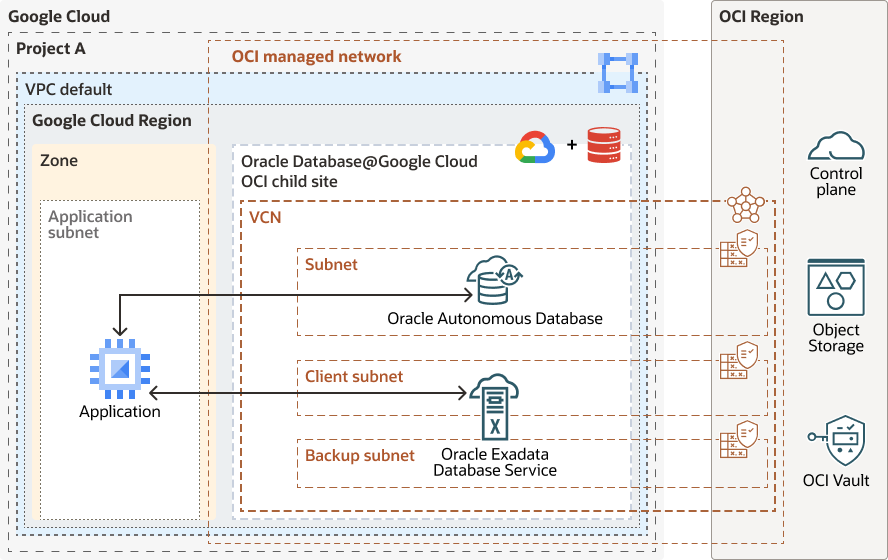Learn About Oracle Database@Google Cloud
Oracle Database@Google Cloud is the Oracle Database service on OCI managed by Oracle, running inside Google Cloud data centers.
Oracle Database@Google Cloud brings Oracle technologies—such as Oracle Exadata Database Service, Oracle Autonomous AI Database, Oracle Real Application Clusters (Oracle RAC), Oracle Database Autonomous Recovery Service, and Oracle Data Guard—into Google Cloud. The solution integrates into Google Cloud networking and Google Cloud Virtual Private Cloud (VPC) access.
You can manage the service on the Google Cloud console or by using Google Cloud automation tools. Oracle Database@Google Cloud consists of a fully-managed Oracle Autonomous AI Database and a co-managed Oracle Exadata Database Service. Both services are natively integrated in Google Cloud, which provides a simple, secure, and low latency operating environment. Google Cloud IAM and Admin provide federated identity and access management for Oracle Exadata Database Service. You can deploy this across multiple regions to ensure business continuity and cloud resilience.
In this solution, you learn about the available network topology considerations and options for selecting the one best suited to your organizational needs.
Before You Begin
- Oracle Autonomous Database Serverless
- Oracle Exadata Database Service on Dedicated Infrastructure
- Planning for Google Cloud IP Address Space
Review the following documentation:
Architecture
This architecture shows a detailed topology for Oracle Database@Google Cloud:
google-detailed-arch-oracle.zip
The architecture displays application resources within a VPC of a Google Cloud project, located in a single zone of a Google Cloud region. An application subnet in the VPC connects to Oracle Database@Google Cloud using the ODB network in the OCI child site, located in the same Google Cloud region. The client subnet of the Oracle Autonomous Database Serverless, the Oracle Exadata Database Service on Dedicated Infrastructure client subnet, and the backup subnets of Oracle Database Autonomous Recovery Service are defined in the ODB network. The VCN extends into the OCI region to enable connections to other resources within OCI. The OCI region hosts the following OCI services: OCI Vault, OCI Object Storage, and control plane.
Considerations for Networking
When selecting a network topology, consider the following requirements:
- Select or create an ODB network to associate your Oracle Autonomous AI Database or Oracle Exadata Database Service.
- Carve out a non-overlapping CIDR range with the VPC subnets.
- Define one CIDR for the client and backup subnet to accommodate future growth.
Note:
Oracle Autonomous AI Database is automatically configured for local backups in the OCI region. Both the backup and restore processes are initiated through Oracle Database Autonomous Recovery Service.